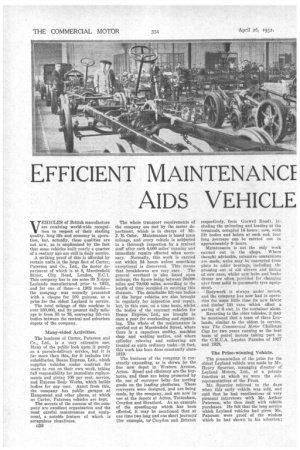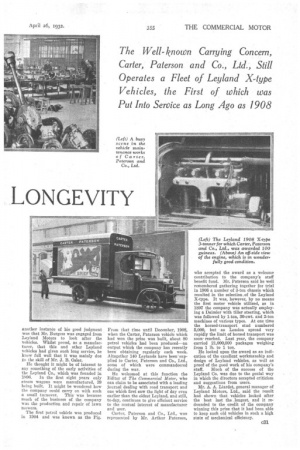EFFICIENT MAINTENANCE AIDS VEHICLE LONGEVITY
Page 52

Page 53

If you've noticed an error in this article please click here to report it so we can fix it.
VEHICLES of British manufacture are receiving world-wide recognition in respect of their sterling quality, long life and economy in operation, but, actually, these qualities are not new, as is emphasized by the fact that some vehicles built nearly a quarter of a century ago are still in daily service.
A striking proof of this is afforded by certain units in the large fleet of Carter, Paterson and Co., Ltd., the motor department of which is at 8, Macclesfield Street, City Road, London, E.C.1. This company has in use some 30 X-type Leylands manufactured prior to 1913, and for one of these—a 1908 model— the compan.y was recently presented with a cheque for 100 guineas, as a prize for the oldest Leyland in service.
The total mileage of this machine is over 380,000, and its present daily mileage is from 55 to 75, conveying lift-van bodies between the central and suburban depots of the company.
Many-sided Activities.
The business of Carter, Paterson and Co., Ltd., is a very extensive one. Many of the public look upon it purely as a parcels-delivery service, but it is far more than this, for it includes two subsidiaries, Beans Express, Ltd., which supplies vehicles under contract for users to run on their own work, taking full responsibility for immediate replacements and giving 100 per cent, service, and Express Body Works, 'which builds bodies for any user. Apart from this, the company has public garages at Hampstead and other places, at which no Carter, Paterson vehicles are kept.
The secrets of the success of the company are excellent organization and the most careful maintenance and equipment, a notable feature of which is scrupulous cleanliness.
ci30
The whole transport requirements of the company are met by the motor department, which is in charge of Mr. J. B. Osier. Maintenance is based upon mileage, and every vehicle is subjected to a thorough inspection by a trained staff after each 4,000 miles' running and immediate repairs effected when necessary. Normally, this work is carried• Out within 24 hours unless something exceptional is discovered. This means that breakdowns are very rare. The general overhaul is also based upon mileage, the figure being between 50,000 miles and 70,000 miles, according to the length of time occupied in covering this distance. The detachable lift-van bodies of the larger vehicles are also brought in regularly for inspection and repair, but, in this case, on a time basis, whilst the bodies of the contract vehicles for Beans Express,' Ltd., are brought in once a year for overhauling and repainting. The whole of the maintenance is carried out at Macclesfield Street, where there is a capacious smithy, machine shop and welding section, and where cylinder reboring and resleeving are treated as quite ordinary tasks—in fact, this work has been done constantly since1919.
The business of the company is constantly expanding, as is shown by the fine new depot in Western Avenue, Acton. Speed and efficiency are the keynotes, and these are being promoted by the use r■f conveyer belts for sorting goods on the loading platforms. These conveyers were designed, and are being made, by the company, and are now in use at the depots at Acton, Tottenham, Croydon and Stratford. As an example of the speeding-up which has been effected, it may be mentioned that at one time two long and one short journeys' (for example, to' Croydon and Brixton
respectively, from Goswell Road), including the uploading and loading at the terminals, occupied 14 hours now, with lift bodies and hoists at each end, four long journeys can be carried out in approximately 9 hours.
Maintenance is not the only work carried out in the shops. Where thought advisable, extensive conversions are made, axles may be converted from plain to roller bearings, including the pressing out of old sleeves and fitting of new ones, whilst new hubs and brake drums are often provided for changing over from solid to pnenmatic tyre equipment.
Bodywork is always under review, and the company has now had in operation for some little time its new fabric and timber lift vans which effect a saving of 6 cwt. in the container alone.
Reverting to the older vehicles, it may be mentioned that a team of three Leylands, similar to the oldest in service, won The Commercial Motor Challenge Cup for two years running as the best team of petrol motors taking part in the C.M.U.A. London Parades of 1927 and 1928.
The Prize-winning Vehicle.
The presentation of the prize for the oldest Leyland vehicle was made by Mr. Henry Spurrier, managing director of Leyland Motors, Ltd., at a private function at which we were the sole representatives of the Press.
Mr. Spurrier referred to the days when this early vehicle was sold, and said that he had recollections of very pleasant interviews with Mr. Arthur Paterson, who then dealt with vehicle purchases. He felt that the long service which Leyland vehicles had given Mr. Paterson were proof of the wisdom which he had shown in his selection;
another instance of his good judgment was that Mr. Burgess was engaged from Leyland Motors to look after the vehicles. Whilst proud, as a manufacturer, that this and other Leyland vehicles had given such long service, he knew full well that it was mainly due to the skill of Mr. J. B. Osier.
He thought it might be of interest to say something of the early activities of the Leyland Co., which was founded in 1896. In the first eight years only steam wagons were manufactured, 39 being built. It might be wondered how the company could carry on with such
a small turnover. This was because 11.11Lell of the business of the company was the production and repair of lawn mowers.
The first petrol vehicle was produced in 1904 and was known as the Pig. From that time until December, 1908, when the Carter, Paterson vehicle which had won the prize was built, about SO petrol vehicles had been produced—an output which the company has recently been obtaining regularly each week. Altogether 140 Leylands have been'supplied to Carter, Paterson and Co., Ltd., some of which were commandeered during the war.
He welcomed at this function the Editor of The Commercial Motor, who can claim to be associated with a leading journal dealing with road transport and one which first saw the light of day even earlier than the oldest Leyland, and still, to-day, continues to give efficient service to the mutual interest of manufacturer an d user.
Carter, Paterson and Co., Ltd., was represented by Mr. Arthur Paterson,
who accepted the award as a welcome contribution to the company's staff benefit fund. Mr. Paterson said he well remembered gathering together for trial in 1908 a number of 3-ton chassis which resulted in the selection of the Leyland X-type. It was, however, by no means the first motor vehicle utilized, as in 1897 the company was actually employing a Daimler with tiller steering, which was followed by 1-ton, 30-cwt, and 2-ton machines of various types. At one time the horsed-transport stud numbered 5,000, but as London spread very rapidly the limit of horsed transport was soon, reached. Last year, the company carried 21,000,000 packages weighing from 1 lb. to 1 ton.
He looked upon the award as an indication of the excellent workmanship and design of Leyland vehicles, as -well as proof of the good work of his company's staff. Much of the success of the Leyland Co. was due to the genial way in which the directors accepted criticism and suggestions from users.
Mr. A. A. Liardet, general manager of Leyland Motors, Ltd., said the result had shown that vehicles looked after the best last the longest, and it redounded to the credit of the company winning this prize that it had been able to keep such old vehicles in such a high state of mechanical efficiency.












































































































